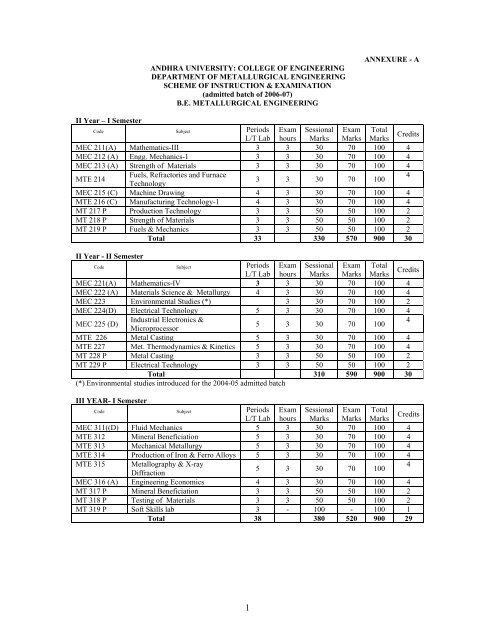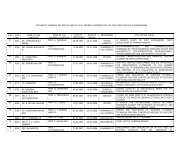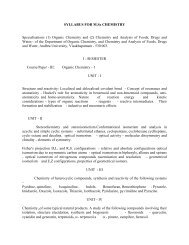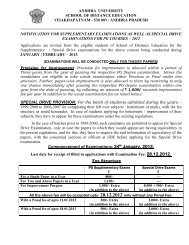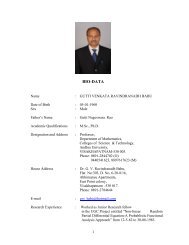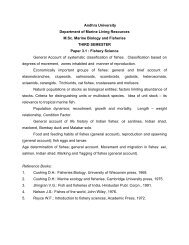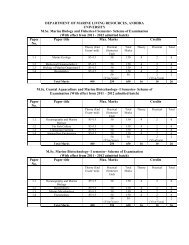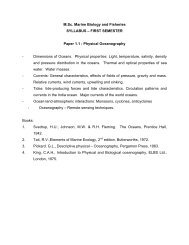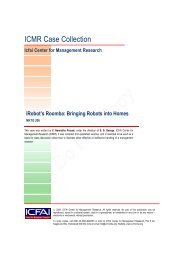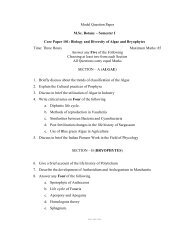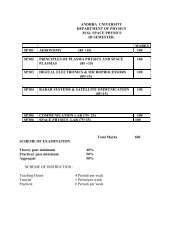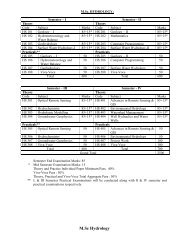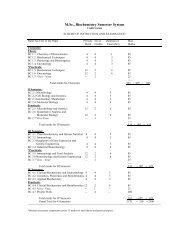annexure - a andhra university: college of engineering department
annexure - a andhra university: college of engineering department
annexure - a andhra university: college of engineering department
Create successful ePaper yourself
Turn your PDF publications into a flip-book with our unique Google optimized e-Paper software.
II Year – I Semester<br />
ANDHRA UNIVERSITY: COLLEGE OF ENGINEERING<br />
DEPARTMENT OF METALLURGICAL ENGINEERING<br />
SCHEME OF INSTRUCTION & EXAMINATION<br />
(admitted batch <strong>of</strong> 2006-07)<br />
B.E. METALLURGICAL ENGINEERING<br />
Code Subject Periods<br />
MEC 211(A) Mathematics-III<br />
MEC 212 (A) Engg. Mechanics-1<br />
MEC 213 (A) Strength <strong>of</strong> Materials<br />
MTE 214<br />
Fuels, Refractories and Furnace<br />
Technology<br />
MEC 215 (C) Machine Drawing<br />
MTE 216 (C) Manufacturing Technology-1<br />
MT 217 P Production Technology<br />
MT 218 P Strength <strong>of</strong> Materials<br />
MT 219 P Fuels & Mechanics<br />
Total<br />
L/T Lab<br />
3<br />
3<br />
3<br />
1<br />
3<br />
4<br />
4<br />
3<br />
3<br />
3<br />
33<br />
Exam<br />
hours<br />
3<br />
3<br />
3<br />
II Year - II Semester<br />
Code Subject Periods<br />
L/T Lab<br />
Exam<br />
hours<br />
MEC 221(A) Mathematics-IV<br />
3 3<br />
MEC 222 (A) Materials Science & Metallurgy 4 3<br />
MEC 223 Environmental Studies (*)<br />
3<br />
MEC 224(D) Electrical Technology<br />
5 3<br />
MEC 225 (D)<br />
Industrial Electronics &<br />
Microprocessor<br />
5 3<br />
MTE 226 Metal Casting<br />
5 3<br />
MTE 227 Met. Thermodynamics & Kinetics 5 3<br />
MT 228 P Metal Casting<br />
3 3<br />
MT 229 P Electrical Technology<br />
Total<br />
3 3<br />
(*) Environmental studies introduced for the 2004-05 admitted batch<br />
III YEAR- I Semester<br />
Code Subject Periods<br />
MEC 311((D)<br />
MTE 312<br />
MTE 313<br />
MTE 314<br />
MTE 315<br />
MEC 316 (A)<br />
MT 317 P<br />
MT 318 P<br />
MT 319 P<br />
Fluid Mechanics<br />
Mineral Beneficiation<br />
Mechanical Metallurgy<br />
Production <strong>of</strong> Iron & Ferro Alloys<br />
Metallography & X-ray<br />
Diffraction<br />
Engineering Economics<br />
Mineral Beneficiation<br />
Testing <strong>of</strong> Materials<br />
S<strong>of</strong>t Skills lab<br />
Total<br />
L/T Lab<br />
5<br />
5<br />
5<br />
5<br />
5<br />
4<br />
3<br />
3<br />
3<br />
38<br />
3<br />
3<br />
3<br />
3<br />
3<br />
3<br />
Exam<br />
hours<br />
3<br />
3<br />
3<br />
3<br />
3<br />
3<br />
3<br />
3<br />
-<br />
Sessional<br />
Marks<br />
30<br />
30<br />
30<br />
30<br />
30<br />
30<br />
50<br />
50<br />
50<br />
330<br />
Sessional<br />
Marks<br />
30<br />
30<br />
30<br />
30<br />
30<br />
30<br />
30<br />
50<br />
50<br />
310<br />
Sessional<br />
Marks<br />
30<br />
30<br />
30<br />
30<br />
30<br />
30<br />
50<br />
50<br />
100<br />
380<br />
Exam<br />
Marks<br />
70<br />
70<br />
70<br />
70<br />
70<br />
70<br />
50<br />
50<br />
50<br />
570<br />
Exam<br />
Marks<br />
70<br />
70<br />
70<br />
70<br />
70<br />
70<br />
70<br />
50<br />
50<br />
590<br />
Exam<br />
Marks<br />
70<br />
70<br />
70<br />
70<br />
70<br />
70<br />
50<br />
50<br />
-<br />
520<br />
ANNEXURE - A<br />
Total<br />
Marks<br />
Credits<br />
100 4<br />
100 4<br />
100 4<br />
100<br />
4<br />
100<br />
100<br />
100<br />
100<br />
100<br />
900<br />
4<br />
4<br />
2<br />
2<br />
2<br />
30<br />
Total<br />
Marks<br />
Credits<br />
100 4<br />
100 4<br />
100 2<br />
100 4<br />
100<br />
4<br />
100<br />
100<br />
100<br />
100<br />
900<br />
4<br />
4<br />
2<br />
2<br />
30<br />
Total<br />
Marks<br />
Credits<br />
100 4<br />
100 4<br />
100 4<br />
100 4<br />
100<br />
4<br />
100<br />
100<br />
100<br />
100<br />
900<br />
4<br />
2<br />
2<br />
1<br />
29
III YEAR- II Semester<br />
Code Subject Periods<br />
L/T Lab<br />
MTE 321<br />
MEC 322(C)<br />
MTE 323<br />
MEC324 (C)<br />
MTE 325<br />
MTE 326<br />
MTE 327 P<br />
Physical Metallurgy<br />
Design <strong>of</strong> Machine Elements-1<br />
Non-Ferrous Extractive<br />
Metallurgy<br />
Industrial Engg. and Management<br />
Metal Forming<br />
Metal joining<br />
Physical Metallurgy<br />
Total<br />
2<br />
5<br />
5<br />
5<br />
4<br />
5<br />
5<br />
3<br />
32<br />
Exa<br />
m<br />
hours<br />
3<br />
3<br />
3<br />
3<br />
3<br />
3<br />
3<br />
Sessional<br />
Marks<br />
30<br />
30<br />
30<br />
30<br />
30<br />
30<br />
50<br />
230<br />
Exam<br />
Mark<br />
s<br />
70<br />
70<br />
70<br />
70<br />
70<br />
70<br />
50<br />
470<br />
Total<br />
Marks<br />
100<br />
100<br />
100<br />
100<br />
100<br />
100<br />
100<br />
700<br />
Credit<br />
s<br />
Note: Industrial Training for a minimum <strong>of</strong> three weeks at the end <strong>of</strong> III Year II Semester during summer vacation. Assessment <strong>of</strong> the Industrial Training is made during IV<br />
Year I-Semester.<br />
IV Year - 1st Semester<br />
Code Subject Periods<br />
MTE 411 Corrosion & Protection<br />
MTE 412 (A) Heat & Mass Transfer<br />
MTE 413 Heat Treatment<br />
MTE 414 Steel Making<br />
MT 415 P Heat & Mass Transfer<br />
MT 416 P Heat Treatment<br />
MT 417 P Industrial Training<br />
Total<br />
IV Year – II Semester<br />
L/TLab<br />
5<br />
5<br />
5<br />
5<br />
3<br />
3<br />
-<br />
26<br />
Code Subject Periods<br />
MEC 421 (A)<br />
MEC 422 (A)<br />
MT 424 P<br />
MT 425 P<br />
MT 426 P<br />
Instrumentation & Control<br />
Systems<br />
Computer Aided Design<br />
Electro Metallurgy<br />
Computer Aided Design Lab<br />
Project work<br />
Total<br />
L/TLab<br />
5<br />
5<br />
5<br />
3<br />
8<br />
31<br />
Exam<br />
hours<br />
3<br />
3<br />
3<br />
3<br />
3<br />
3<br />
-<br />
Exam<br />
hours<br />
3<br />
3<br />
3<br />
-<br />
Sessional<br />
Marks<br />
30<br />
30<br />
30<br />
30<br />
50<br />
50<br />
100<br />
320<br />
Sessional<br />
Marks<br />
30<br />
30<br />
50<br />
50<br />
50<br />
160<br />
A: Common for Mech, M.P.I., Metallurgy, Mech. Marine and Naval Architecture<br />
C: Common for Mech, M.P.I., Metallurgy and Mech. Marine<br />
D: Common for Mech, and M.P.I & Metallurgy<br />
Exam<br />
marks<br />
70<br />
70<br />
70<br />
70<br />
50<br />
50<br />
-<br />
380<br />
Exam<br />
marks<br />
70<br />
70<br />
50<br />
-<br />
50<br />
290<br />
4<br />
4<br />
4<br />
4<br />
4<br />
4<br />
2<br />
26<br />
Total<br />
Marks<br />
Credits<br />
100 4<br />
100 4<br />
100 4<br />
100 4<br />
100 2<br />
100 2<br />
100 2<br />
700 22<br />
Total<br />
Marks<br />
Credits<br />
100<br />
4<br />
100<br />
100<br />
50<br />
100<br />
450<br />
4<br />
2<br />
2<br />
8<br />
20
DEPARTMENT OF METALLURGICAL ENGINEERING<br />
II YEAR – 1 ST SEMESTER SYLLABUS<br />
(2006-07 ADMITTED BATCH)<br />
MEC 211: MATHEMATICS-III<br />
(Common with Mechanical Engineering)<br />
Periods/week: 3 Credits: 4 Sessionals: 30 Exam:70<br />
Vector calculus. Differentiation <strong>of</strong> vectors, curves in space, Velocity and acceleration, Relative<br />
velocity and acceleration, Scalar and Vector point functions – Vector operation del. Del applied to scalar point<br />
functions – Gradient, Del applied to vector point functions – Divergence and Curl. Physical interpretation <strong>of</strong> div<br />
F curl. F del applied twice to point functions, Del applied twice to point functions, Integration <strong>of</strong> vectors, Line<br />
integral- Circulation – Work surface integral – Flux, Green’s theorem in the plane, Stoke’s theorem, Orthogonal<br />
curvilinear co-ordinates Del applied to functions in orthogonal curvilinear co-ordinates, Cylindrical coordinates<br />
– spherical polar co-ordinates.<br />
Partial differential equations. Formation <strong>of</strong> partial differential equations, Solutions <strong>of</strong> a partial<br />
differential equation, Equations Solvable by direct integration. Linear equations <strong>of</strong> the first order, Homogenous<br />
linear equations with constant coefficients, Rules for finding the complementary function, Rules for finding the<br />
particular integral, working procedure to solve homogenous linear equations <strong>of</strong> any order. Non-homogeneous<br />
linear equations.<br />
Applications <strong>of</strong> Partial Differential equations. Introduction, Methods <strong>of</strong> separation <strong>of</strong> variables, partial<br />
differential equations <strong>of</strong> Engineering, Vibration <strong>of</strong> a stretched stirring-wave equation, One-dimensional heat<br />
flow, Two dimensional heat flow, Solution <strong>of</strong> Laplace’s equation, Laplace’s equation in polar co-ordinates .<br />
Integral Transforms. Introduction, Definition, Fourier integrals-Fourier sine and cosine integralscomplex<br />
forms <strong>of</strong> Fourier integral, Fourier transform-Fourier sine and cosine transforms – finite Fourier sine<br />
and cosine transforms, Properties <strong>of</strong> F-transforms, Convolutions theorem for properties F-Transforms,<br />
Paraseval’s identity for F-transforms, Relation between Fourier and Laplace transforms, Fourier transforms <strong>of</strong><br />
the derivatives <strong>of</strong> a function, Inverse Laplace transforms by method <strong>of</strong> residuals, Application <strong>of</strong> transforms to<br />
boundary value problems.<br />
Text books: 1. Higher Engineering Mathematics, by B.S.Grewal, Khanna Publishers, New Delhi-<br />
110006. 34 th Edition,1998.<br />
Reference:<br />
1. A text book <strong>of</strong> Engineering Mathematics – NP Balietal, Laxmi Publications (P) Limited, New Delhi-110002<br />
2. Higher Engineering Mathematics – Dr MK Venkataraman, National Pub.Co. Madras-1<br />
3. Advanced Mathematics for Engineering Students, Vol.2 and Vol.3 - Narayan, Manicavachagaon<br />
Pillay and Ramanaiah.<br />
4. Advanced Engineering Mathematics, - Erwin Kreyszig, Wiley Easter Pvt. Ltd., New Delhi- 49<br />
5. Engineering Mathematics by P.P.Gupta , Krishna Prakasham Media(P) Ltd, Meerut Vol-2.<br />
6. Advanced Engineering Mathematics by V.P.Jaggi and A.B.Mathur, Khanna Pub. New Delhi-6<br />
7. Engineering Mathematics by S.S.Sastry, Prentice Hall <strong>of</strong> India, Pvt. Ltd., New Delhi-1<br />
8. Advanced Engineering Mathematics by Pr<strong>of</strong>.H.K.Dass, S.Chand and Co. Ltd. New Delhi-51.<br />
3
MEC 212(A): ENGINEERING MECHANICS –I<br />
(Common for Mech., M.P.I., Metallurgy, Mech.Marine and Naval Architecture)<br />
Periods/week: 5 L Credits: 4 Sessionals: 30 Exam: 70<br />
Concurrent forces in a plane and its equilibrium. Centroids <strong>of</strong> composite plane figures. General case <strong>of</strong><br />
forces in a plane. Moment <strong>of</strong> inertia <strong>of</strong> plane figures. Parallel axis theorem. Polar MI. Concept <strong>of</strong> mass MI.<br />
Rectilinear translation. Kinematics. Principle <strong>of</strong> dynamics. Motion <strong>of</strong> a particle under constant force. Force<br />
proportional to displacement and free vibrations (SHM) . D’Albert’s principle. Momentum. Impulse work and<br />
energy. Rotation <strong>of</strong> a rigid body about a fixed axis kinematics. Equation <strong>of</strong> motion <strong>of</strong> a rigid body about a fixed<br />
axis. Rotation under constant moment. Torsional vibration.<br />
Text books:<br />
1. Engineering Mechanics – S.Timoshenko (relevant sections only)<br />
2. Elements <strong>of</strong> Strength <strong>of</strong> Materials- S.Thimoshanko (relevant sections only)<br />
MEC 213 (A) STRENGTH OF MATERIALS<br />
(Common for Mech., M.P.I., Metallurgy, Mech. Marine and Naval Architecture)<br />
Periods/week: 5 L Credits: 4 Sessionals: 30 Exam: 70<br />
Simple stresses and strains. Stresses on inclined plane. 2-Dimensional stress systems. Principal stress<br />
and principal planes. Mohr’s circle. Shearing force and bending moment. Types <strong>of</strong> loads. Types <strong>of</strong> supports. SF<br />
and BM diagrams for formula. Bending stresses in the above types <strong>of</strong> beams with rectangular and circular<br />
sections. Torsion <strong>of</strong> circular shafts. Determination <strong>of</strong> shear stress.<br />
Text books:<br />
1. Engineering Mechanics – S.Timoshenko (relevant sections only)<br />
2. Elements <strong>of</strong> Strength <strong>of</strong> Materials- S.Thimoshanko (relevant sections only)<br />
MTE 214 FUELS, REFRACTORIES AND FURNACE TECHNOLOGY<br />
Periods/week: 3L-2T Credits: 4 Sessionals: 30 Exam: 70<br />
Solid fuels. Classification. Theories <strong>of</strong> formation <strong>of</strong> coal. Study types and properties <strong>of</strong> coal.<br />
Proximate analysis & ultimate analysis <strong>of</strong> coal. Carbonization <strong>of</strong> coal. Coke and by products. Testing and<br />
properties. Liquid fuels. Classification. Theories <strong>of</strong> formation <strong>of</strong> petroleum. Petroleum refining. Distillation.<br />
Synthetic petrol. Bergius process. Fischer-Trospesch process. Coal tar fuels. Testing and properties. Gaseous<br />
fuels. Classification. Production <strong>of</strong> PG,WG, CWG,LD gas, Coke oven gas and BF gas. Industrial gasification<br />
processes. Lurgi, Winklers and Kopper_ Totzek processes. Properties and testing. Liquid and gaseous fuel<br />
burners. Combustion problems.<br />
Refractories. Definition . Properties, classification and general description. Manufacturing <strong>of</strong><br />
refractories. Manufacture, properties and applications <strong>of</strong> Alumino-silicate, Silica, Dolomite, Magnesite,<br />
Chromite and Carbon refractories. Importance and study <strong>of</strong> SiC,ZrO2 and cermets. Testing <strong>of</strong> refractories.<br />
Furnaces. Classification <strong>of</strong> furnaces and their use in metallurgical industries. Elements <strong>of</strong> heat<br />
transmission. Steady state conduction, convection and radiation. Heat utilization in furnaces, available heat,<br />
factors affecting it. Heat losses in furnaces and furnace efficiency. Heat balance and Sankey diagrams.<br />
Principles <strong>of</strong> waste heat recovery. Recuperators and regenerators. Types and applicability. AMTD and LMTD in<br />
recuperators. Protective atmosphere and their applications . Salt bath furnaces.<br />
Text books:<br />
1. Fuels, furnaces and refractories by O.P.Gupta<br />
References:<br />
1. Fuels, Technology by Hinues<br />
2. Fuels by Gilechrist<br />
3. Refractories by Chesty<br />
4
MEC 215 (C) MACHINE DRAWING<br />
(Common with Mech., M.P.I, Metallurgy and Mech. Marine)<br />
Periods/week:4P Credits: 4 Sessionals:30 Exam: 70<br />
Screw threads and Screw Fastening using standard empirical formulae. Riveted joints, Keys, Cotterjoints,<br />
Pin-joints. Shaft couplings: Box and split muff couplings, Flanged, Flexible. Universal and Oldham<br />
couplings. Shaft bearings . Brackets and Hangers. Pipe joints.<br />
Orthogonal view and sectional views <strong>of</strong> machine parts. Assembly drawing <strong>of</strong> various engine<br />
components and machine tool components.<br />
Text books:<br />
1. Machine Drawing, N.D.Bhatt, Charotal Publishing House.<br />
2. Engineering Drawing, A.C.Parkinson,Wheeler publishing.<br />
MTE 216 © MANUFACTURING TECHNOLOGY-1<br />
(Common with Mech., M.P.I, Metallurgy and Mech.Marine)<br />
Periods/week:4P Credits: 4 Sessionals:30 Exam: 70<br />
Manufacturing concepts; Product cycle; Job, batch and mass production; Primary and secondary manufacturing<br />
processes; Principle <strong>of</strong> metal casting; Terminology; Pattern; Types; Allowances; Materials; Core boxes;<br />
Selection; Testing and preparation <strong>of</strong> moulding sands; Moulding tools and equipment; Machine moulding; Core<br />
making; Sprue; Runner, gates and risers; Types and designing; Melting and pouring the metal; Shell mold<br />
casting; Investment casting; Permanent mould casting; Casting defects.<br />
Formability <strong>of</strong> metals; Cold and hot working; Rolling; Types; Roll size; Stretch forming, metal spinning,<br />
embossing and coining; Peening; Sheet metal forming operations; Presses; Die design.<br />
Forging materials; Forging processes; Forging techniques; Forging presses; Forging pressure distribution and<br />
forging force; Automation <strong>of</strong> forging; Swaging; Drawing; Extrusion; High energy rate forming.<br />
Weldability; Welding metallurgy; Principles and processes <strong>of</strong> arc welding (SMAW, GTAW, GMAW, FCAW,<br />
PAW, SAW); Welding equipment; Weld positioners and fixtures; Oxyacetylene welding; Flame cutting;<br />
Brazing and soldering; Principle <strong>of</strong> resistance welding; Types <strong>of</strong> resistance welds; Seam welding; Projection<br />
welding; Resistance butt welding; Solid state welding; Weld inspection and testing.<br />
Text Book:<br />
1. Process and Materials <strong>of</strong> Manufacture (4 th Edition) by Roy A. Lindberg, Prentice-Hall <strong>of</strong> India Private<br />
Limited.<br />
Reference Books:<br />
1. Manufacturing Engineering & Technology by Kalpak Jain, Addition Wesley Edition.<br />
2. Materials and Processes in Manufacturing by De Margo, Black and Kohsen, Prentice Hall <strong>of</strong> India.<br />
3. Principles <strong>of</strong> Metal Casting by Hein and Rosenthol, Tata Mc-Graw Hill India.<br />
4. Manufacturing Technology-Foundary, Forming and Welding by P.N. Rao, Tata McGraw-Hill Publishing<br />
Company.<br />
5
MT 217 P Production Technology<br />
Periods/week: 3P Credits: 2 Sessioanls: 50 Exam:50<br />
Use <strong>of</strong> basic tools and operations <strong>of</strong> the following trades.<br />
S.No. Trade Number <strong>of</strong> jobs<br />
1 Foundry 3<br />
2 Welding 2<br />
3 Lathe Step and taper turning-1<br />
4 Milling Thread cutting -1<br />
Offset turning - 1<br />
5 Shaper Spur gear-1<br />
MT 218 P Strength <strong>of</strong> Materials<br />
Periods/week: 3P Credits: 2 Sessionals: 50 Exam: 50<br />
List <strong>of</strong> Experiments:<br />
1. To study the stress strain characteristics <strong>of</strong> metals by using UTM by tension test.<br />
2. To study the stress strain characteristics <strong>of</strong> metals by using Hounsfield tensometer.<br />
3. Determination <strong>of</strong> compression strength <strong>of</strong> wood.<br />
4. Determination <strong>of</strong> hardness using different hardness testing testing machines-<br />
Brinnels, Vickers and Rockwell’s<br />
5. Impact test by using Izod & charpy methods.<br />
6. Deflections test on beams using UTM.<br />
7. Tension shear test on MS rods.<br />
8. To find stiffness & modulus <strong>of</strong> rigidity by conducting compression tests on springs.<br />
9. Torsion tests on M.S.Shafts.<br />
10. Bulking <strong>of</strong> sand.<br />
11. Punch shear test, hardness test & compression test by using Hounsfield tensometer.<br />
12. Hardness test using UTM<br />
13. Sieve analysis and determination <strong>of</strong> fineness number.<br />
MT 219 P FUELS & MECHANICS<br />
Periods/week: 3 Credits: 2 Sessional: 50 Exam:50<br />
List <strong>of</strong> experiments:<br />
1. To assemble the given parts <strong>of</strong> the mechanism kit for different types <strong>of</strong> mechanisms<br />
2. To determine the moment <strong>of</strong> inertia <strong>of</strong> the given fly wheel.<br />
3. To determine the moment <strong>of</strong> inertia <strong>of</strong> the given connecting rod.<br />
4. To determine the modulus <strong>of</strong> rigidity <strong>of</strong> the given wire with torsional pendulum.<br />
5. To determine the coefficient <strong>of</strong> friction with Thurston oil tester.<br />
6. Study and valve timing diagrams <strong>of</strong> four stroke and two stroke engine.<br />
7. Study <strong>of</strong> boilers, fuel pumps, carburetors etc.<br />
8. To determine the volumetric efficiency <strong>of</strong> the given air compressor by<br />
1. Plate orifice method and 2. Tank capacity method.<br />
9. To calibrate the given pressure gauge.<br />
10. Determination <strong>of</strong> Flash and fire points <strong>of</strong> oils.<br />
11. Determination <strong>of</strong> Calorific value <strong>of</strong> fuels(solids, liquid, gaseous) by bomb<br />
Calorimeter/gas calorimeter.<br />
12. To determine the kinematic and absolute viscosity <strong>of</strong> the given sample oil using<br />
Redwood Viscometer I.<br />
13. To determine the kinematic and absolute viscosity <strong>of</strong> the given sample oil using<br />
Redwood Viscometer II.<br />
14. Determination <strong>of</strong> carbon residue.<br />
6
II YEAR - II SEMESTER<br />
MEC 221(A) Mathematics -IV<br />
(Common for Mech., M.P.I., Metallurgy, Mech.Marine and Naval Architecture)<br />
Periods/week: 3L Credits: 4 Sessional: 30 Exam: 70<br />
Functions <strong>of</strong> a complex variable. Introduction f(z) its limit and continuity. Derivative <strong>of</strong> f(z) – Cauchy-<br />
Rieman equations, Analytic functions, Harmonic functions.<br />
Orthogonal system, Applications to flow problems, Integration <strong>of</strong> complex functions, Cauchy’s inequality,<br />
Lioville’s theorem, Poission’s integral formulae series <strong>of</strong> complex terms- Taylor’s series – Laurent’s series,<br />
singular points-Residues, Reside theorem, Calculation <strong>of</strong> residues , Evaluation <strong>of</strong> real definite integrals,<br />
Geometrical representations, Special conformal transformations.<br />
Statistical Methods. Probability. Addition law <strong>of</strong> probability, Independent events, Multiplication law <strong>of</strong><br />
probability distribution, Continuous probability distribution, Expectation, Moment generating, function,<br />
repeated trials, Binomial distribution, Poisson distribution, Normal distribution, Probable error, Normal<br />
approximation to Binominal distribution, Some other distributions, sampling, sampling distribution, standard<br />
error, Testing <strong>of</strong> hypothesis, Level <strong>of</strong> significance, Confidence limits, simple sampling <strong>of</strong> attributes, Sampling<br />
<strong>of</strong> variables- Large samples, Sampling <strong>of</strong> variables- Small samples, Student’s l-distribution, x 2 -distribution, Fdistribution,<br />
Fisher’s Z-distribution.<br />
Difference equations and Z-Transforms. Z-transform- Definition, Some standard Z- transforms, Linear<br />
property, Damping rule, Some standard results, Shifting rules, Initial and final value theorems Convolution<br />
theorem, Evaluation <strong>of</strong> inverse transforms, Definition, order and solution <strong>of</strong> a difference equation, Formation <strong>of</strong><br />
difference equations, Linear difference equations, Rule for finding C.F., Rules for finding P.I., Difference<br />
equations reducible to linear form, Simultaneous difference equations with constant coefficients, Application to<br />
deflection <strong>of</strong> a loaded string, Application <strong>of</strong> Z-transform to difference equations.<br />
Text book:<br />
1. Higher Engineering Mathematics, by Dr.B.S.Grewal, Khanna publishers, New Delhi-110 006,<br />
34 th editon, 1998.<br />
Reference:<br />
1. A text book <strong>of</strong> Engineering Mathematics by N.P.Balietal, Laxmi publications(p) limited,<br />
New Delhi-110 002.<br />
2. Higher Engineering Mathematics, by Dr.M.K.Venkataraman, National Pub. Co., Madras-1<br />
3. Advanced Mathematics for Engineering students, Vol.2 and Vol.3 by Narayanan,Manica-<br />
vachagaon Pillay and Ramanaiah<br />
4. Advanced Engineering Mathematics, by Erwin Kreyszig, Wiley Eastern Pvt.Ltd. New Delhi-49.<br />
5. Engineering Mathematics by P.P.Gupta, Krishna Prakasham Media (P) Limited Meerut Vol.2<br />
6. Advanced Engineering Mathematics by V.P.Jaggi and A.B.Mathur Khanna Pub.<br />
New Delhi-6.<br />
7. Engineering Mathematics by S.S.Sastry, Prentice Hall <strong>of</strong> India, Pvt.Ltd., New Delhi-1<br />
8. Advanced Engineering Mathematics by Pr<strong>of</strong>.H.K.Dass, S.Chand and Co. Ltd, New Delhi-51<br />
9. Engineering Math ematics Vol.2 by Tarit Majumdar, New Central Book Agency (P)<br />
Ltd., Calcutta-9<br />
7
MEC 222(A) Material Science & Metallurgy<br />
(Common for Mech., M.P.I, Metallurgy, Mech. Marine and Naval Architecture)<br />
Periods:4 Credits: 4 Sessional:30 Exam:70<br />
Space lattice and unit cells, crystal systems. Indices for planes and directions. Structures <strong>of</strong> common<br />
metallic materials. Crystal defects: point, Line and surface defects.<br />
Binary phase diagrams. Gibbs rule. Lever rule. Invariant reactions. Iron-Iron carbide phase diagram.<br />
Heat treatment <strong>of</strong> steel. Isothermal transformations curves. Annealing, Normalizing, Hardening, Tempering,<br />
austempering and martempering <strong>of</strong> steels. Surface hardening <strong>of</strong> steels. Carburizing, nit riding, cyaniding, Flame<br />
and induction hardening methods.<br />
Classification <strong>of</strong> Steels ; I.S., AISI-SAE classifications. Uses and limitations <strong>of</strong> plain-carbon steels,<br />
alloy steels. Plain carbon and low alloy steels. Tool steels. Stainless steels. Cast irons. Gre, white, Malleable and<br />
SG irons, Alloy cast irons. Non-Ferrous metals and alloys; brasses and bronzes, bearing metals.<br />
Plastic deformation: slip, twinning critical resolved shear stress. Ductile and Brittle fracture.<br />
Mechanism <strong>of</strong> creep and fatigue. High temperature alloys. Metals at low temperature. Effect <strong>of</strong> low temperature<br />
on properties: low temperature metals.<br />
Composite materials. Classification. Matrices and reinforcements. Fabrication methods. Examples and<br />
applications.<br />
NDT Testing: Ultrasonic, Magnetic, Dye penetrant and visual methods and applications radiographic.<br />
TEXT BOOKS:<br />
1. Material Science and Engineering by V.Raghavan<br />
2. Physical Metallurgy by S.H.Avner.<br />
REFERENCE BOOKS:<br />
1. Material Science and Engineering by L.H.Van Vleck, 5 th edition, Addision Wealey(1985)<br />
2. Structure and properties <strong>of</strong> Materials by R.M.Rose, L.A.Shepard and J.Wulff, Vol.1,4 John<br />
Willey (1966) .<br />
3. Essentials <strong>of</strong> Material Science by A.G.Guy, McGraw Hill(1976).<br />
4. The Science and Engineering Materials by D.R.Askeland. 2 nd Edition, Chapman and Hall<br />
(1990).<br />
8
MEC 223: ENVIRONMENTAL STUDIES<br />
Periods/week: 3L-2T Credits: 2 Sessional: 30 Exam: 70<br />
Introduction to Environmental Studies – Importance – Types <strong>of</strong> Ecosystems – Lake-River-<br />
Marine-Forest-Desert-Bio-Deversity.<br />
Resources Natural – Water- Mineral-Food- Forest – Energy-Land-Use and Exploitation-<br />
Environmental Degradation- Remedial measures.<br />
Environmental Pollution causes, Effects, standards and control (A) Air pollution ; (b) Water<br />
Pollution; (c) Soil pollution; (d) Marine pollution; (e) Noise pollution<br />
Legal aspects <strong>of</strong> pollution<br />
(a) Air (Prevention and control <strong>of</strong> pollution) Act<br />
(b) Water (Prevention and control <strong>of</strong> pollution) Act<br />
(c) Environmental Protection 1980 Act.<br />
(d) Forest Conservation Act.<br />
Role <strong>of</strong> People to protect environment-Rolle <strong>of</strong> NGOS<br />
(a) Global issues (b) Green House Effect (c) Global Warming (d) Nuclear accidents<br />
(B) Local issues causes and action<br />
© Air pollution due to industries<br />
(D)Automobiles<br />
C. Public interest Litigation case studies-Success stores<br />
Leather industries<br />
Taaj * Mathura Refinery<br />
Silent Valley<br />
TEXT BOOKS<br />
(A) Introduction to einvrionmental sciences – Turk & Turk and Witties<br />
(B) Environmental Sciences – P.D.Sarma<br />
9
MEC 224 (D) ELECTRICAL TECHNOLOGY<br />
(Common for Mech, and M.P.I. & Metallurgy)<br />
Periods/week: 3L-2T Credits: 4 Sessional:30 Exam: 70<br />
Magnetic circuits. Definitions <strong>of</strong> magnetic circuit, Reluctance, Magnetomotive force (m.m.f), magnetic<br />
flux, simple problems on magnetic circuits, Hystersis loss.<br />
(Chapter 8, Page Nos.155-175)<br />
Electromagnetic induction. Faraday’s law <strong>of</strong> electromagnetic induction, induced E.M.F., Dynamically<br />
induced E.M.F. Statically induced EMF ,Self-inductance, and mutual inductance.<br />
(Chapter 9, Page Nos.176-190)<br />
D.C. generators. D.C. Generator principle, construction <strong>of</strong> D.C. generator, E.M.F. equation <strong>of</strong> D.C.<br />
generator, types <strong>of</strong> D.C. generators, Armature reaction, Losses in D.C. generator, Efficiency, characteristics <strong>of</strong><br />
D.C. generators, Applications <strong>of</strong> D.C. generator.<br />
(Chapter 10,11, Page Nos.208-238)<br />
D.C. Motors. D.C. Motor principle, working <strong>of</strong> D.C. Motors, significance <strong>of</strong> back E.M.F., Torque<br />
equation <strong>of</strong> D.C. motors, types <strong>of</strong> D.C. motors, characteristics <strong>of</strong> D.C. motors, speed control methods <strong>of</strong> D.C.<br />
motors, Applications <strong>of</strong> D.C. motors, Testing <strong>of</strong> D.C. machine: losses and efficienc6y, Direct load test and<br />
Swinburne’s test.<br />
(Chapter 12,13, Page Nos.239-267)<br />
A.C. Circuit: Introduction to steady state analysis <strong>of</strong> A.C. circuits. Single and balanced 3 phase circuits.<br />
(chapter 16, Page Nos.323-348)<br />
Transformers. Transformer principle, EMF equation <strong>of</strong> transformer, Transformer on load, Equivalent<br />
circuit <strong>of</strong> Transformer, Voltage regulation <strong>of</strong> transformer, losses in a transformer, Calculation <strong>of</strong> efficiency and<br />
regulation by open circuit and short circuit tests.<br />
(Chapter 20, Page Nos.423-455)<br />
Three phase inductance motor. Induction motor working principle. Construction <strong>of</strong> 3 phase induction<br />
motor, principle <strong>of</strong> operation. Types <strong>of</strong> 3 phase induction motor, Torque equation <strong>of</strong> induction motor, Slip-<br />
Torque characteristics, Starting Torque, Torque under running condition, Maximum Torque equation, power<br />
stages <strong>of</strong> induction motor, efficiency calculation <strong>of</strong> induction motor by direct loading.<br />
(Chapter 21, Page Nos.463-489)<br />
Alternator. Working principle, EMF equation <strong>of</strong> Alternator, Voltage regulation by Sync. Impedance<br />
method.<br />
(Chapter 23, Page Nos.505-515)<br />
Synchronous Motor. Synchronous motor principle <strong>of</strong> operation., Construction, Methods <strong>of</strong> starting <strong>of</strong><br />
synchronous motor.<br />
(Chapter 24, Page Nos.516-526)<br />
Electrical measurements. Principles <strong>of</strong> measurement <strong>of</strong> current, Voltage power and energy, Ammeters,<br />
Voltmeters, Wattmeter’s ,Energy Meters, Electrical conductivity Meter, Potientio meter and Megger.<br />
Text book:<br />
1. Elements <strong>of</strong> Electrical Engineering and Electronics by V.K.Mehta, S.Chand & Co.<br />
Reference book:<br />
1. A first course in Electrical Engineering, by Kothari<br />
10
MEC 225 (D) INDUSTRIAL ELECTRONICS & MICROPROCESSOR<br />
(Common for Mechanical, and M.P.I. & Metallurgy)<br />
Periods/week: 3L-2T Credits: 4 Sessional:30 Exam: 70<br />
Devices. Semi-conductor diode. Zenor diode. Transistor. Silicon control rectifier. Rectifiers.<br />
Amplifiers. Oscillators. Cathode ray oscilloscope. Industrial applications. Poly- phase rectifiers. Control circuits.<br />
Motor speed control. Voltage control. Time delay relay circuits. Photo electric circuits.<br />
Resistance welding, Induction heating-Dielectric heating. Servomechanism: Open loop and closed loop<br />
system (Elementary treatment only).<br />
Introduction to Digital Electronics. Fundamentals <strong>of</strong> digital electronics. Number system and codes.<br />
Logic gates. Boolean algebra. Arithmetic logic units. Flip-flops. Registers and counters.<br />
Memories. ROM,PROM, EPROM and RAM.<br />
Introduction to Microprocessors. The Intel-8085 microprocessor. Architecture. Instruction set.<br />
Execution <strong>of</strong> instructions. Addressing structurism. Timing and machine cycles <strong>of</strong> 8085 and programming I/O<br />
operations. Interrupts. Serial input and serial output. Programming the I/O ports. Programming the timer.<br />
Text books:<br />
1. Industrial Electronics by Mithal (Khanna Publications)<br />
2. Digital Computer Electronics – An introduction to Micro Computer, Albert Paul Malvino.<br />
Tata Mc Graw Hill Publishing Co. Ltd., New Delhi-2.<br />
Reference:<br />
1. Engineering Electronics by Ryder-McGraw Hill.<br />
2. Micro Processor by Leventhal.<br />
MTE 226 METAL CASTING<br />
Periods/week: 3L-2T Credits: 4 Sessional: 30 Exam: 70<br />
Introduction. Status <strong>of</strong> foundry industry and comparison with other manufacturing processes. Types <strong>of</strong><br />
foundries. Basic operations. Patterns. Pattern making. Materials for pattern making. Types <strong>of</strong> patterns . Pattern<br />
allowance. Core boxes. Moulding materials. Properties. Preparation and testing.<br />
Moulding processes. Sand mounding. Mounding techniques. Hand and machine compaction. Machine<br />
moulding. Cores and core making. Sodium silicate processes. Shell, Investment and Die-casting. Centrifugal<br />
casting.<br />
Solidification – Crystallization and development <strong>of</strong> cast structure. Directional solidification and single<br />
crystal growth. Foundry characteristics. Principles <strong>of</strong> gating and risering. Casting design considerations.<br />
General principles <strong>of</strong> melting Cupola and its operation. Modern developments in cupola. Melting<br />
practice <strong>of</strong> Al, Cu and Mg alloys. Defects in castings. Fettling. Inspection and quality control. Metallurgy <strong>of</strong> cast<br />
irons. Foundry practices <strong>of</strong> white cast iron gray cast iron, S.G. and malleable iron. Alloy cast iron. Steel foundry<br />
practice.<br />
Modernization and mechanization <strong>of</strong> foundries.<br />
Text books:<br />
1. Principles <strong>of</strong> Metal Casting, Heine, Loper and Rosenthal, Tata Mc Grawhill<br />
2. Foundry Technology, P.C.Jain, Tata Mc Grawhill<br />
3. Foundry Technology, P.R.Beeely, London-Buterworths.<br />
11
MTE 227: METALLURGICAL THERMODYNAMICS & KINETICS<br />
Periods/week: 3L-2T Credits: 4 Sessional: 30 Exam:70<br />
Introduction. Basic concepts in thermodynamics. Objectives and limitations <strong>of</strong> classical<br />
thermodynamics. Zeroth law <strong>of</strong> thermodynamics.<br />
First law <strong>of</strong> thermodynamics. Internal energy and work. Calculation <strong>of</strong> work for various<br />
thermodynamic processes. Heat capacities. Thermo chemistry. Hess’s law. Kirch<strong>of</strong>f’’s law.<br />
Second law <strong>of</strong> Thermodynamics. Efficiency <strong>of</strong> cyclic process. Carnot cycle. Entropy. Thermodynamic<br />
equation <strong>of</strong> state. Statistical interpretation <strong>of</strong> entropy. Free energy functions. Gibbs- Helmholtz equation.<br />
Maxwell’s relations. Third law <strong>of</strong> Thermodynamics.<br />
Fugacity, activity and equilibrium constant. Vant H<strong>of</strong>f’s isotherm. Variation <strong>of</strong> equilibrium constant<br />
with temperature. Clausius-Clapeyron’s equation. Ellingham diagrams and application.<br />
Thermodynamic solutions . Raoult’s law. Henry’s law. Sievert’s law. Properties <strong>of</strong> ideal solutions,<br />
chemical potentials. Partial Molar properties and their inter relations. Gibbs Duhem equation and its integration.<br />
Actual solutions. Regular solutions. Excess thermodynamic properties. Application to phase diagrams.<br />
Derivation <strong>of</strong> phase rule. Thermodynamics <strong>of</strong> Electrochemical cells. Nernst equation. Emf method <strong>of</strong><br />
measurement <strong>of</strong> Thermodynamic properties.<br />
Kinetics <strong>of</strong> Metallurgical reactions. Collision theory. Theory <strong>of</strong> absolute reaction rates. Order and<br />
molecularity <strong>of</strong> reactions. Determination <strong>of</strong> order. Catalysis and chemical reactions.<br />
Text books:<br />
1. Physical Chemistry <strong>of</strong> Metals, L.S.Darken and G.Gurry, Tata Mc-Graw hill.<br />
Reference:<br />
1. Chemical Metallurgy, J.J.Moore<br />
2. Problems in Thermodynamics & Kinetics, G.S.Upadhyaya and R.N.Dubey<br />
3. Metallurgical Thermodynamics, ML Kapoor Part I & II<br />
4. Metallurgical Thermodynamics, Tupkary<br />
12
MT 228P: METAL CASTING<br />
Periods/week: 3P Credits: 2 Sessional: 50 Exam: 50<br />
List <strong>of</strong> Experiments<br />
1. Determination <strong>of</strong> AFS grain fineness number.<br />
2. Determination <strong>of</strong> AFS clay contact.<br />
3. Determination <strong>of</strong> permeability <strong>of</strong> moulding sands.<br />
4. Determination <strong>of</strong> GCS, GSS & DCS & DSS <strong>of</strong> moulding sands.<br />
5. Determination <strong>of</strong> flowability and compatibility <strong>of</strong> moulding sands.<br />
6. Determination <strong>of</strong> moisture content.<br />
7. Determination <strong>of</strong> shatter index.<br />
8. Study on the combined effect <strong>of</strong> Bentonite and moisture on green<br />
properties <strong>of</strong> moulding sands.<br />
9. Study on melting practice and casting <strong>of</strong> simple shapes in Al.<br />
10. Study on casting defects <strong>of</strong> aluminum casting.<br />
11. Study on the effect <strong>of</strong> additives on properties <strong>of</strong> moulding sand.<br />
MT 229 P: ELECTRICAL TECHNOLOGY<br />
Periods/week: 3P Credits: 2 Sessional: 50 Exam: 50<br />
List <strong>of</strong> Experiments:<br />
1. Study on Calibration <strong>of</strong> Ammeter.<br />
2. –do- Voltmeter<br />
3. –do- Watt Meter<br />
4. –do- Energy Meter<br />
5. Measurement <strong>of</strong> low resistance (armature)<br />
6. –do- medium resistance (field)<br />
7. –do- insulation resistance<br />
8. –do- filament resistance<br />
9. Verification <strong>of</strong> KCL and KLV<br />
10. Superposition theorem.<br />
11. Parameters <strong>of</strong> choke oil<br />
12. OC and SC tests on transformer<br />
13. OC and load test D.C. shunt machine<br />
14. OC and Load test on D.C. separately excited machine<br />
15. Swinburnes test<br />
16. 3 Phase induction motor( No load and rotor block tests) load test<br />
17. Alternator regulation by syn. Impedance method<br />
13
III YEAR-1 ST SEMESTER – SYLLABUS<br />
MEC 311(D) FLUID MECHANICS<br />
(Common for Mech, and M.P.I. & Metallurgy)<br />
Periods/week: 3L-2T Credits: 4 Sessional: 30 Exam: 70<br />
Properties <strong>of</strong> fluids-Viscosity – Pressure measurement and Manometers – Hydrostatic forces on<br />
surfaces.<br />
Fluid Kinematics & Fluid Dynamics. Stream line- Stream tube – Stream function – Potential function –<br />
Classification <strong>of</strong> flows – Steady, Unsteady, Uniform, Non-uniform, Laminar, Turbulent, Rotational, Irrotational<br />
flows, Vorticity, and circulation- Conservation <strong>of</strong> mass- Equation <strong>of</strong> continuity, Conservation <strong>of</strong> momentum-<br />
Euler’s equation, Conservation <strong>of</strong> energy – Bernoulli’s equation and its applications- Vortex motion – Free and<br />
forced vortices- Basic solutions <strong>of</strong> ideal fluid flows-Flow net analysis.<br />
One-dimensional Viscous flow. Couette flow- Plane couetee flow, Favourable pressure gradient and<br />
adverse pressure gradient- Flow through pipes-Hagen poiselle flow- Fannings friction factor – Darey’s<br />
Weisbach friction factor – Loss <strong>of</strong> head due to friction in pipes – Laminar and turbulent regimes – Flow<br />
potential and flow resistance – Flow through branched pipes, Momentum equation-Forces due to pipe bends,<br />
Curved tubes, Sudden enlargement, Sudden contraction flow through porous media- Darey’s equation . Two<br />
Dimensional Viscous Flow: Navier stokes equations and solutions – Order <strong>of</strong> magnitude analysis- Boundary<br />
layer equations.<br />
Laminar Boundary Layer. Momentum integral equation- Flow over a flat plate- Displacement<br />
thickness, Momentum thickness and energy thickness.<br />
Turbulent Boundary Layer. Laminar –Turbulent transition-Momentum equations and Reynold’s<br />
stresses- Fully developed turbulent flow through a pipe – Turbulent boundary layer on a flat plate – Laminar<br />
sub-layer – Boundary layer separation and control.<br />
Dimensional Analysis and Modeling Similitude. Fundamental and derived dimensions – Dimensionless<br />
groups – Buckingham - theorem – Rayleigh method- Model testing – Types <strong>of</strong> similarity – Geometric ,<br />
Kinematic and Dynamic similarities- Hydraulic diameter.<br />
Compressible fluid flow. Thermodynamic relations – Continuity, Momentum and Energy equations-<br />
Velocity <strong>of</strong> sound in a compressible fluid- Mach number and its significance – Limits <strong>of</strong> incompressibility –<br />
Pressure field due to a moving source <strong>of</strong> disturbance – Propagation <strong>of</strong> pressure waves in a compressible fluids-<br />
Stagnation properties – Stagnation pressure, Temperature and density – Area velocity relationship for<br />
compressible flow – Flow <strong>of</strong> compressible fluid through nozzles- Condition for maximum discharge through<br />
nozzles – Variation <strong>of</strong> mass flow with pressure ratio – Compressible flow through a venturimenter – Pitot static<br />
tube in a compressible flow.<br />
Text book:<br />
1. Fluid Mechanics, A.K.Mohanty, Prentice Hall <strong>of</strong> India Pvt. Ltd.<br />
Reference:<br />
1. Fluid Mechanics and Hydraulic Machines, R.K.Bansal, Laxmi Publications.<br />
2. Foundations <strong>of</strong> Fluid Mechanics, Yuan, Prentice Hall <strong>of</strong> India.<br />
3. Fluid Mechanics and its applications, S.K.Gupta and A.K.Gupta, Tata McGraw Hill, New Delhi.<br />
14
MTE 312: MINERAL BENEFICIATION<br />
Periods/week: 3L-2T Credits: 4 Sessional: 30 Exam: 70<br />
Objectives and scope. Classification <strong>of</strong> minerals. An elementary concept <strong>of</strong> liberation. Comminution .<br />
Study <strong>of</strong> primary and secondary crushing and grinding units like Jaw, Gyratory, and reduction Gyratory and roll<br />
crushers. Theory <strong>of</strong> Ball Mill operation, Rittinger’s , Kick’s and Bond’s laws <strong>of</strong> crushing and grinding.<br />
Laboratory sizing units. Screening. Ellutriation.Sedimentation. Representation <strong>of</strong> size analysis data.<br />
Sizing equipment used in industry. Elementary concepts <strong>of</strong> movement <strong>of</strong> solids in fluids. Stokes and Newtons<br />
laws. Reynold’s number. Free and hindered settling. Classification and its application in mineral dressing.<br />
Heavy media separation and coal washing. Tabling. Jigging. Magnetic and Electro static separation.<br />
Elementary treatment <strong>of</strong> principles <strong>of</strong> flotation. Surface tension, surface energy, and contact angle. Floatability,<br />
frothers, collectors and modifying agents. Differential flotation. Flotation circuits.<br />
Study <strong>of</strong> basic de-watering techniques like-sedimentation – filtration – drying.<br />
Simple flow sheets for Beneficiation <strong>of</strong> Fe, Mn, Cr, Cu, Pb, Zn and beach sands.<br />
Text books:<br />
1. Principles <strong>of</strong> Mineral Dressing, Gaudin, A.M.<br />
References;<br />
1. Mineral Processing Technology, S.K.Jain<br />
2. Unit operation in Chemical Engineering.<br />
15
MTE 313: MECHANICAL METALLURGY<br />
Periods/week: 3L-2T Credits: 4 Sessionals: 30 Exam: 70<br />
Introduction. Importance <strong>of</strong> testing in quality control.<br />
Tension test. Engineering stress strain curve. True stress and true strain diagram. Instability in tension.<br />
Ductility measurements. Effect <strong>of</strong> temperature and strain rate. Typical stress strain diagrams. Yield point<br />
phenomena. Strain ageing. Bauschinger effect. Compression test. Fundamentals <strong>of</strong> testing . Applications .<br />
Behavior <strong>of</strong> materials in compression.<br />
Hardness test. Introduction. Brinnel, Meyer, Vickers and Rockwell hardness. Rockwell superficial<br />
hardness. Micro hardness. Poldi and shore skelero scope hardness. Relation between hardness and tensile<br />
strength . Hardness conversion. Hardness at elevated temperatures.<br />
Fracture . Introduction. Types <strong>of</strong> fracture in metals. Theoretical cohesive strength <strong>of</strong> metals. Griffith<br />
theory <strong>of</strong> brittle fracture. Metallographic aspects <strong>of</strong> fracture . Fractography . Fracture at low temperature.<br />
Brittle fracture and impact testing: The problems <strong>of</strong> brittle fracture. Notched bar impact tests.<br />
Significance <strong>of</strong> Transition temperature. Metallurgical factors affecting transition temperature. Plane strain<br />
fracture toughness(KIC) . Methods <strong>of</strong> determination.<br />
Fatigue. Introduction. Stress cycles. The S-N diagram. Effect <strong>of</strong> mean stress. Structural features <strong>of</strong><br />
fatigue . Fatigue crack propagation. Effect <strong>of</strong> stress concentration. Size effect. Surface effect. Corrosion fatigue.<br />
PARIS equation.<br />
Creep and stress rupture. High temperature materials problem. Time dependent mechanical behavior.<br />
The creep curve. Stress rupture test. Structural changes during creep. Mechanism <strong>of</strong> creep deformation. Fracture<br />
at elevated temperatures. High temperature alloys. Presentation <strong>of</strong> Engineering creep data. Prediction <strong>of</strong> long<br />
time properties.<br />
An elasticity and internal friction. Theories <strong>of</strong> failure. Von Mises and Treasca Yield criteria.<br />
Miscellaneous tests. Shear test. Testing <strong>of</strong> sheets and tubes.<br />
Non-destructive testing. Principles and applications <strong>of</strong> visual, liquid penetrant and dye penetrant tests.<br />
Fluorescent test. Radiography. X-ray, Gamma ray and Neutron methods. Sonic and ultrasonic methods <strong>of</strong><br />
inspection. Magnetic methods. Magna flux and magna glow methods. De magnetization. Eddy current tests.<br />
Pressure testing.<br />
Text books:<br />
1. Mechanical Metallurgy, George E.Dieter, Mc Grawhill<br />
2. Testing <strong>of</strong> materials, A.V.K. Suryanarayana, Prentice hall <strong>of</strong> India.<br />
References:<br />
1. Testing <strong>of</strong> Engineering Materials, Donald et.al., McGraw Hill<br />
2. Metals hand book<br />
16
MTE 314: PRODUCTION OF IRON & FERRO ALLOYS<br />
Periods/week: 3L-2T Credits: 4 Sessionals: 30 Exams: 70<br />
Raw materials. Occurrence and distribution <strong>of</strong> iron ores in India. Evaluation <strong>of</strong> iron ore., coke and<br />
limestone. Preparation <strong>of</strong> iron ores. Concentration. Sintering principles. Sintering machine and its efficiency.<br />
Types <strong>of</strong> sinter. Raw material requirements. Pelletising. Bonding mechanism. Equipment . Firing units.<br />
Blast furnace and accessories. Description <strong>of</strong> modern blast furnace. Design <strong>of</strong> blast furnace. Stoves.<br />
Gas cleaning system. Charging system. Blast furnace instruments and refractories . Distribution <strong>of</strong> burden in<br />
blast furnace.<br />
Physical chemistry. Distribution <strong>of</strong> elements in molten metal and slag. Constitution <strong>of</strong> blast furnace<br />
slag’s, properties and uses. Blast furnace operation, irregularities and corrections. Modern developments in blast<br />
furnace practice and methods <strong>of</strong> increasing production. Alternate routes <strong>of</strong> production <strong>of</strong> pig iron. Electric<br />
process. Low shaft furnace. Production <strong>of</strong> sponge iron by HYL process, SL/RN process. Midrex process. Kiln<br />
process. Uses <strong>of</strong> sponge iron. Production <strong>of</strong> wrought iron.<br />
Text books:<br />
1. Introduction to modern iron making, R.H. Tupkary<br />
2. Introduction to modern iron making, A.K. Biswas<br />
3. Physical Chemistry <strong>of</strong> Iron & Steel Making, C.Bodsworth<br />
References:<br />
1. MSTS-United Steel Corporation, Pittsburgh<br />
2. Blast furnace theory & practice- Vol.I & II ,Julius JH.Strysbugen<br />
MTE 315 METALLOGRAPHY & X-RAY DIFFRACTION<br />
Periods/week: 3L-2T Credits: 4 Sessionals: 30 Exams: 70<br />
1. Metallographs- Macro and Micro examination <strong>of</strong> examination <strong>of</strong> metals and alloys, principles <strong>of</strong><br />
construction <strong>of</strong> optical and electron microscopes. Resolution and magnification . Optical aberrations and<br />
correction for image quality. Specimen preparation, technique for transmission Electron microscopy.<br />
2. Production and properties <strong>of</strong> X-rays, Electromagnetic radiation, continuous and characteristics<br />
spectrum, absorption. Fillers. Production and detection <strong>of</strong> X-rays. Diffraction. Barg’s law, scattering by atom,<br />
electron , unit cell, structure factor calculation.<br />
3. Diffraction Methods: Laue’s method, rotating crystal, Debye scherrer – Specimen preparation, film<br />
loading, powder method, Determination <strong>of</strong> crystal structure, determination <strong>of</strong> crystal structure, determination <strong>of</strong><br />
precision lattice parameter, sources <strong>of</strong> error in measurements.<br />
4. Applications – Determination <strong>of</strong> orientation simple crystal, back reflection and transmission Laue<br />
method, effect <strong>of</strong> plastic deformation. Determination <strong>of</strong> particle size, grain size, residual stresses, determination<br />
<strong>of</strong> phase diagrams, order-disorder transformation.<br />
5. Chemical Analysis by X-ray techniques, X-ray fluorescence. X-ray specto meters, qualitative and<br />
quantitative analysis, micro analysis <strong>of</strong> metals and alloys, LDX,WDX.<br />
Text books:<br />
1. X-ray diffraction – B.D.Cullity<br />
2. Transmission Electro Microsopy-G.Thomas.<br />
17
MEC 316 (A) ENGINEERING ECONOMICS<br />
(Common for Mech., M.P.I., Metallurgy, Mech.Marine and Naval Architecture)<br />
Periods/week: 4L Credits: 4 Sessional: 30 Exam: 70<br />
Utility, Value, wealth, consumption, wants- necessaries , comforts and luxuries. Laws <strong>of</strong> demand,<br />
Elasticity <strong>of</strong> demand. Production , Agents <strong>of</strong> production, Laws <strong>of</strong> returns. Forms <strong>of</strong> business organization. Singe<br />
trader, partnership and public limited company. Price determination <strong>of</strong> perfect competition, Monopoly and<br />
imperfect competition. Rent, interest, money, cheques, bills <strong>of</strong> exchange. Costing-cost concepts, Elements <strong>of</strong><br />
cost, Methods <strong>of</strong> distribution <strong>of</strong> overhead costs. Unit costing, Job costing and process costing. Break-Even<br />
analysis , Depreciation methods, preparation <strong>of</strong> pr<strong>of</strong>it & loss account and balance sheet (outlines only).<br />
Text books: 1. Engineering Economics, Vol.1, Tara Chand<br />
Reference:<br />
1. A text book <strong>of</strong> Economic Theory, Dhingra and Grag.<br />
2. Cost accounts by Shukla and Grewal.<br />
MT 317 P: MINERAL BENEFICIATION<br />
Periods/week: 3P Credits: 2 Sessional: 50 Exam: 50<br />
LIST OF EXPERIMENTS:<br />
1. Sampling by coning and quartering, riffle sampler.<br />
2. Determination <strong>of</strong> average particle size by sieve analysis.<br />
3. Determination <strong>of</strong> optimum time <strong>of</strong> sieving.<br />
4. Studies on size reduction using laboratory Jaw Crusher.<br />
5. Studies on size reduction using laboratory Roll Crusher.<br />
6. Studies on size reduction using laboratory Ball Mill.<br />
7. Heavy media separations(sink and float experiment)<br />
8. Laboratory experimentation Froth Flotation.<br />
9. Determination <strong>of</strong> Grindability <strong>of</strong> Coal.<br />
MT 318 P: TESTING OF MATERIALS<br />
Periods/week: 3P Credits: 2 Sessional: 50 Exam:50<br />
List <strong>of</strong> Experiments:<br />
1. Dye-Penetrant Test.<br />
2. Magnetic crack detector.<br />
3. Ericsen Cupping Test<br />
4. Tensile & Bend Testing<br />
5. Coating thickness<br />
6. Shore seleroscope hardness test<br />
7. Testing <strong>of</strong> a welded joint<br />
8. Poldi Testing<br />
9. Cold working & annealing<br />
10. Fatigue testing<br />
11. Impact testing<br />
18
MT 319 P: SOFT SKILL LAB<br />
Periods/week: 3P Credits: 1 Sessional: 100<br />
Communication:<br />
Importance <strong>of</strong> communication<br />
Non verbal communication<br />
Personal appearance<br />
Posture<br />
Gestures<br />
Facial expressions<br />
Eye contact<br />
Space distancing<br />
Goal setting:<br />
Immediate, short term, long term,<br />
Smart goals, strategies to achieve goals<br />
Time management:<br />
Types <strong>of</strong> time<br />
Identifying time wasters<br />
Time management skills<br />
Leadership and team management:<br />
Qualities <strong>of</strong> a good leader<br />
Leadership styles<br />
Decision making<br />
Problem solving<br />
Negotiation skills<br />
Group discussions:<br />
Purpose (Intellectual ability, creativity, approach to a problem, solving, tolerance, qualities <strong>of</strong><br />
a leader)<br />
Group behavior, Analyzing performance<br />
Job interviews:<br />
Identifying job openings<br />
Preparing resumes & CV<br />
Covering letter<br />
Interview (Opening, body-answer Q, close-ask Q),<br />
Types <strong>of</strong> questions<br />
Reference books:<br />
1. ‘Effective Technical Communications’ by Rizvi M. Ashraf, McGraw–Hill Publication<br />
2. ‘Developing Communication Skills’ by Mohan Krishna & Meera Banerji, Macmillan<br />
3. ‘Creative English for Communication’ by N.Krishnaswami & T.Sriraman, Macmillan<br />
4. ‘Pr<strong>of</strong>essional Communication Skills’ by Jain Alok, Pravin S.R. Bhatia & A.M. Sheikh,<br />
S.Chand & Co.<br />
19
III YEAR- II SEMESTER<br />
MTE 321: PHYSICAL METALLURGY<br />
Periods/week: 3L-2T Credits: 4 Sessionals: 30 Exam: 70<br />
Phase rule, principles <strong>of</strong> construction and interpretation <strong>of</strong> binary phase diagrams.Invariant reactions.<br />
Free energy composition diagrams, uses and limitations <strong>of</strong> phase Diagrams, Equilibrium and non-equlibrium<br />
phases, important phase diagrams-Fe-C,Cu-Za, Cu-Sn, Al-Si, Al-Cu, Ph-Sn. Sub-Sn, Ternary diagrams and<br />
interpretation <strong>of</strong>Structures on cooling.<br />
Solidification: Solidification <strong>of</strong> pure metals, alloys and eutectic. Homogenous and Heterogeneous<br />
nucleation, constitutional super cooling, segregation, porosity, Directional solidification, microstructure <strong>of</strong><br />
solidified metals, zone refining<br />
Diffusion <strong>of</strong> metals-Fick’s law, mechanisms <strong>of</strong> diffusion, solutions to diffusion Equations,<br />
diffusion in alloys, Kirkendalefect, Factors affecting, diffusion, grain Boundary diffusion, applications.<br />
Recovery, recrystallisation and grain-growth, strengthening mechanisms – grain boundary<br />
strengthening, solid solution strengthening, deformation <strong>of</strong> two phase aggregates, strengthening from fine<br />
particles, Fibers strengthening, Martensite -strengthening, strain hardening, preferred orientation.<br />
Text books:<br />
1. Physical Metallurgy - S.H.Avner<br />
2. Physical Metallurgy - V.Raghavan<br />
3. Physical Metallurgy - Vijendra Singh<br />
4. Mechanical Metallurgy - G.E. Dieter<br />
Reference book:<br />
1. Physical Metallurgy - R.E.Reed Hill<br />
20
MEC 322 (c) DESIGN OF MACHINE ELEMENTS<br />
(Common for Mech., and M.P.I. & Metallurgy)<br />
Periods/week: 3L-2T Credits: 4 Sessionals: 30 Exam: 70<br />
Mechanical Engineering Design, Traditional design methods. Design synthesis. Design considerations<br />
<strong>of</strong> standards. Engineering materials classification and selection. BIS designation <strong>of</strong> steels. Mechanical<br />
properties., Manufacturing considerations. Statistical considerations.<br />
Design against static loads. Modes <strong>of</strong> failure. Factory <strong>of</strong> safety. Stress-strain relations. Axial, bending<br />
and torsional stresses. Stress concentration factors. Fluctuations and fatigue stresses. Endurance limit. North<br />
sensitivity. Soderberg, Goodman and modified Goodman diagrams, fatigue design under combined loading.<br />
Thread and welded joints. Torque requirement for bolt tightening. Eccentrically loaded bolted joints.<br />
Fluctuations loads on bolted joints. Joints with combined stresses. Power screws and different forms <strong>of</strong> threads.<br />
Force analysis. Collar friction. Differential and compound screws design. Types and strength <strong>of</strong> weld joints<br />
subjected to bending and fluctuating loads.<br />
Power transmission shafts. Design <strong>of</strong> hollow shafts. Keys and cotter design. Flat, square keys. Splines<br />
and proportions. Rigid and flange couplings. Flexible coupling. Flywheel designs. Torque analysis. Stresses in<br />
rimmed flywheel.<br />
Mechanical springs, classification spring materials. Spring end formation. Design <strong>of</strong> Helical springs.<br />
Torsional springs. Laminated springs. Protective coatings. Equalized stressing spring leaves. Multi-leaf springs.<br />
Nipping and shot peening.<br />
Text books:<br />
1. Design <strong>of</strong> Machine Elements, V.B. Bhandari, TMH Publishing Co. Ltd., New Delhi<br />
Reference:<br />
1. Machine Design, R.K,Jain, Khanna Publications.<br />
2. Mechanical Engineering Design,J.E.Shigley.<br />
21
MTE 323: NON-FERROUS EXTRACTIVE METALLURGY<br />
Periods/week: 3L-2T Credits: 4 Sessionals: 30 Exam: 70<br />
Introduction. Non-ferrous mineral wealth <strong>of</strong> India. Primary and secondary metal winning.<br />
General Methods <strong>of</strong> Extraction. Pyro-metallurgy. Roasting. Types <strong>of</strong> roasting. Roasting equipment and<br />
methods. Predominance area diagrams. Smelting. Smelting furnaces. Principles <strong>of</strong> refining. Use <strong>of</strong> vacuum.<br />
Zone refining. Vacuum are re-melting. Electron beam melting. Electro slag refining. Hydro Metallurgy.<br />
Advantages and disadvantages. Principles <strong>of</strong> leaching. Leaching kinetics and factors affecting. Electro<br />
Metallurgy. Classification <strong>of</strong> process. Cementation. Electro refining, Electro deposition.<br />
Extraction <strong>of</strong> Metals: Aluminum. Uses. Ores. Bayer’s process <strong>of</strong> Alumina production. Hall-Heroult<br />
process. Cryolite and carbon electrode manufacture. Hoopes process <strong>of</strong> refining. Indian plant practice. New<br />
processes. Alcoa process.<br />
Copper. Uses. Pyro-metallugical processes. New processes. Flash smelting. WORCA and Noranda<br />
processes. Hydro-metallurgy <strong>of</strong> copper. Copper production in India.<br />
Lead. Uses. Ores. Treatment <strong>of</strong> ore and production <strong>of</strong> metal.<br />
Zinc. Uses. Pyro-metallurgical and hydro-metallurgical extraction methods. Imperial smelting<br />
process. Nickel : Brief description <strong>of</strong> Ni extraction from sulphide ores. Magnesium. Uses. Ores. Pidegon’s<br />
process. Extraction by Dows process. Tin: Uses. Ores. Concentration, smelting and refining.<br />
Uranium. Extraction <strong>of</strong> Uranium. Production flow sheet <strong>of</strong> Jaduguda ore zirconium. Zirconium<br />
production in India. Brief outlines <strong>of</strong> extraction <strong>of</strong> Pu and Th. Titanium. Production <strong>of</strong> Titanium chloride from<br />
Hmentite. Production <strong>of</strong> Ti sponge. Brief production flow sheets <strong>of</strong> extraction <strong>of</strong> Gold and Silver.<br />
Nuclear Rector Technology. Fuel for nuclear reactors. Basic components <strong>of</strong> a reactor characteristics<br />
and requirements. Types <strong>of</strong> reactor.<br />
Text books:<br />
1. Extraction <strong>of</strong> Non-Ferrous Metals, H.S.Ray, R.Sridhar and K.P.Abraham<br />
References:<br />
1. Metallurgy <strong>of</strong> Non-Ferrous Metals, Dennis, W.H.<br />
2. Non-Ferrous Metallurgy, Sebryukov, N.Min, Pub. Moscow<br />
22
MEC (C) 324: INDUSTRIAL ENGINEERING & MANAGEMENT<br />
(Common for Mech., M.P.I., Metallurgy & Mech. Marine)<br />
Periods/week: 3L-2T Credits: 4 Sessionals: 30 Exam: 70<br />
Concepts <strong>of</strong> Industrial Management. Principles <strong>of</strong> management – Growth <strong>of</strong> management thought<br />
functions <strong>of</strong> management, principles <strong>of</strong> organization, types <strong>of</strong> organization and committees.<br />
Introduction to personnel management. Functions. Motivation. Theories <strong>of</strong> motivation. Hawthrone<br />
studies, Discipline in industry, Promotions, Transfer lay <strong>of</strong>f and discharge, Labour turnover.<br />
Industrial relations. Trade unions. Industrial disputes, Strikes, Lockout, Picketing, Gherao, Settlement<br />
<strong>of</strong> industrial disputes, Collective bargaining, Industrial Dispute Act 1947 and Factories Act 1948.<br />
Production planning and control. Types <strong>of</strong> productions, Production cycle, product design and<br />
development, Process planning, forecasting, loading, scheduling, dispatching, routing, progress, control, simple<br />
problems.<br />
Plant layout. Economics <strong>of</strong> plant location, Rural Vs Suburban sites, types <strong>of</strong> layouts, types <strong>of</strong> building,<br />
travel chart technique. Assembly line balancing simple problems.<br />
Materials handling principles, concept <strong>of</strong> unit load, containerization, pelletisation, selection <strong>of</strong> material<br />
handling equipment, Applications <strong>of</strong> belt conveyors, cranes, Forklift trucks in industry.<br />
Plant Maintenance. Objective and types.<br />
Work-study <strong>of</strong> productivity (simple problems)<br />
Method study. Basic steps in method study. Process chart symbols. Charts, Diagrams and models used,<br />
Principles <strong>of</strong> motion economy, Therbligs, Simo chart. Work measurement- Stop watch procedure <strong>of</strong> time study,<br />
Performance rating and allowances, work sampling, Simple problems.<br />
Materials Management . Introduction, Purchasing, Objectives <strong>of</strong> purchasing <strong>department</strong>, Buying<br />
techniques, Purchase procedure, Stores and material control, Receipt and issue <strong>of</strong> materials, Store records.<br />
Quality control-Single and double sampling plans. Control charts <strong>of</strong> variables and attributes (use <strong>of</strong><br />
formulae only).<br />
Text book:<br />
1. Industrial Engineering Management, Dr.O.P.Khanna<br />
References:<br />
1. Principles <strong>of</strong> Management, Koontz & Donnel.<br />
2. Production and Operations Management, Everette Adam & Ronald Ebert<br />
3. Operations Management, John McClain & Joseph Thames.<br />
23
MTE 325: METAL FORMING<br />
Periods/week: 3L-2T Credits: 4 Sessionals: 30 Exam: 70<br />
Fundamentals <strong>of</strong> metal working. Classification <strong>of</strong> forming processes. Flow-stress determination.<br />
Temperature in metal working . Strain-rate effects. Metallurgical Structure . Friction and Lubrication.<br />
Forging classification. Forging equipment. Open die and closed die forging. Calculation <strong>of</strong> forging<br />
loads in closed die forging. Forging defects. Rolling classification. Rolling mills and accessories. Hot and cold<br />
rolling. Elements <strong>of</strong> roll pass design. Rolling <strong>of</strong> bars and shapes. Forces and geometric relationships in rolling.<br />
Rolling variables . Problems and defects in rolled products. Torque and Horse power.<br />
Extrusion . Classification. Extrusion equipment . Hot extrusion. Deformation, lubrication and defects<br />
in extrusion. Hydrostatic extrusion. Extrusion <strong>of</strong> tubing. Miscellaneous working operations . Drawing <strong>of</strong> rods<br />
wires and tubes.. Sheet metal forming.<br />
Powder Metallurgy. Methods <strong>of</strong> production <strong>of</strong> metal powders. Particle size analysis. Characterization<br />
<strong>of</strong> metal powders. Compacting, sintering and their mechanisms. Industrial applications.<br />
References:<br />
1. Mechanical Metallurgy by G.E. Dieter McGraw Hill Book Co.,<br />
2. Introduction to Physical Metallurgy by S.H.Anver, McGraw Hill<br />
3. Powder Metallurgy-A.K.Sinha<br />
MTE 326: METAL JOINING<br />
Periods/week: 3L-2T Credits: 4 Sessionals: 30 Exam: 70<br />
Introduction. Importance and classification. Basic concepts in arc welding and gas welding. General<br />
theory <strong>of</strong> arc welding. Principle, operation and application <strong>of</strong> shielded metal arc welding. Tungsten inert gas ,<br />
plasma arc, studs, submerged arc, metal inert gas and CO2 welding processes. Electro-slag welding.<br />
Resistance welding processes. Spot , seam, flash butt, upset butt, Thermit welding, Electron beam and<br />
laser beam welding. Solid state welding processes. Diffusion bonding, ultrasonic. Explosive inertia/friction<br />
welding. Soldering and brazing. Weld defects. Testing , inspection and quality control welds. Weldability and<br />
its testing.<br />
Metallurgical considerations in welding. Structure property changes. Problems during welding <strong>of</strong> high<br />
carbon steels, cart irons, alloy steels, stainless steels. Aluminum alloys, Cu-base alloys. Welding <strong>of</strong> Dissimilar<br />
metals.<br />
Text books:<br />
1. Welding and Welding Technology, R.L.Little<br />
2. Welding Technology, N.K.Srinivasan<br />
MTE 327 P: PHYSICAL METALLURGY<br />
Periods/week: 3 P Credits: 2 Sessional : 50 Exam: 50<br />
About 12 experiments on the Metallography <strong>of</strong> common ferrous and Non-Ferrous metals and alloys,<br />
experiments on thermal analysis.<br />
24
IV YEAR-1 ST SEMESTER<br />
MTE 411: CORROSION & PROTECTION<br />
Periods/week: 3L-2T Credits: 4 Sessionals: 30 Exam: 70<br />
Corrosion –Theoretical aspects. Electrolysis. Principles. Faraday’s laws and their application. Current<br />
efficiency. Energy efficiency. Ion conductivity. Equivalent and motor conductivities. Tonic mobilities and<br />
Transport Nos. Electrode potential, Equilibrium potentials – EMF series. Polarization, over voltage/over<br />
potential. Activation, concentration, Ohmic polarization. Effect <strong>of</strong> polarization on electrode processes.<br />
Corrosion as an irreversible electrode process. Tafels equation. Tafels slopes. Effect <strong>of</strong> Temperature ,<br />
composition and concentration <strong>of</strong> the corrosive media. Kinetics <strong>of</strong> electrode process (briefly) . Passivity.<br />
Electronic processes. Cathodic Technical processes. Brief classification. Anodic technical process.<br />
Corrosion – Electrochemical aspects <strong>of</strong> Corrosion. Corrosion cells/Electro chemical cells, Concentration cells,<br />
Temperature cells. Determination <strong>of</strong> Electrode potential. Thermodynamic aspects-Nerrnest equation, Helmholtz<br />
equation. Galvanic series. Displacement equilibrium and its significance in corrosion processes. Potential – pH,<br />
Fe-H2O diagram. E- I diagrams for prediction <strong>of</strong> corrosion currents. Polarization resistance , Linear polarization<br />
technique for evaluation <strong>of</strong> Icorr.<br />
Corrosion – Practical aspects .Importance. Direct and indirect losses. Types and Forms <strong>of</strong> Corrosion.<br />
Uniform Corrosion, Pitting Corrosion, Galvanic Corrosion, and Integranular Corrosion, Stress Corrosion<br />
cracking. Cavitation Erosion, Erosion Corrosion. Corrosion Fatigue. Differential aeration corrosion. Corrosion<br />
rate expressions. Testing methods. Effect <strong>of</strong> velocity, flow-rate, concentration, temperature and inhibitors on<br />
corrosion rates. Corrosion rate calculations.<br />
Corrosion prevention, 1) Design aspects 2) Alteration <strong>of</strong> Environment inhibitors 3) Alteration <strong>of</strong> the<br />
material . pure metals alloys, Non-metallic as structural materials – Reinforcement <strong>of</strong> the material for reducing.<br />
Corrosion rates. 4) Surface protection. Electroplating , Principles – Throwing power and its evaluation.<br />
Commercial plating <strong>of</strong> Cu, Ni, Cr, Cd, Zn, Ag, Au. Electro-deposition <strong>of</strong> alloys plating structure <strong>of</strong> Electro<br />
deposits and testing <strong>of</strong> deposits. 5) Anodic oxidation <strong>of</strong> Aluminum and its alloys. Commercial anodizing<br />
process. Faults in the anodic coating and the remedies. Treatment after anodizing. 6) Cathodic and Anodic<br />
protection.<br />
Text books:<br />
1. An introduction to Electrometallurgy, Sharan and Narain, Standard Publishers<br />
2. Corrosion Engineering, MG Fountana, Mc-Graw Hill book company<br />
3. Electro Beam Analysis <strong>of</strong> Materials, Loretto.<br />
25
MTE 412 (A) : HEAT & MASS TRANSFER<br />
(Common for Mech, M.P.I., Metallurgy , Mech.Marine and Naval Architecture)<br />
Periods/week: 3L-2T Credits: 4 Sessionals: 30 Exam: 70<br />
Introduction. Basic modes <strong>of</strong> heat transfer-Rate equations-Generalized heat conduction equation in<br />
Cartesian, Cylindrical and spherical coordinate systems.<br />
Steady state heat conduction solution for plain and composite slabs, cylinders and spheres-Critical<br />
thickness <strong>of</strong> insulation- Heat conduction through fins <strong>of</strong> uniform and variable cross section – Fin effectiveness<br />
and efficiency.<br />
Unsteady, steady state heat conduction- Transient heat conduction – Lumped system analysis , and use<br />
<strong>of</strong> Heisler charts.<br />
Convection. Continuity, momentum and energy equations. Dimensional analysis- Boundary layer<br />
theory concepts-Free, and forced convection. Approximate solution <strong>of</strong> the boundary layer equations. Laminar<br />
and turbulent heat transfer correlation. Momentum equation and velocity pr<strong>of</strong>iles in turbulent boundary layers.<br />
Applications <strong>of</strong> dimensional analysis to free and forced convection problems. Empirical correlation.<br />
Radiation. Black body radiation- radiation field, Kirch<strong>of</strong>f’s laws-shape factor – Stefan Boltzman<br />
equation. Heat radiation through absorbing media. Radiant heat exchange, parallel and perpendicular surfaces-<br />
Radiation shields.<br />
Heat exchangers. Types <strong>of</strong> heat exchangers. Parallel flow. Counter flow. Cross flow heat exchangers.<br />
Overall heat transfer coefficient. LMTD and NTU methods. Fouling in heat exchangers. Heat exchangers with<br />
phase change.<br />
Boiling. Different regimes <strong>of</strong> boiling-Nucleate, Transition and film boiling.<br />
Condensation. Laminar film condensation. Nusselt’s theory. Condensation on vertical flat plate and<br />
horizontal tubes- dropwise condensation.<br />
Mass transfer. Conservation laws and constitutive equations. Isothermal equimass, Equimolal<br />
diffusion. Fick’s law <strong>of</strong> diffusion- diffusion <strong>of</strong> gases, liquids- Mass transfer coefficient.<br />
Text books:<br />
1. Heat transfer, J.P. Holman, Int. Student edition, McGraw Hill company.<br />
2. Analysis <strong>of</strong> Heat Transfer, Eckert and Drake, Int. Student edition, McGraw Hill<br />
Kogakusha Ltd.<br />
26
MTE 413: HEAT TREATMENT<br />
Periods/week: 3L-2T Credits: 4 Sessionals: 30 Exam: 70<br />
Phase transformation in Fe-C system, Critical temperatures. Austenite grain size designation.<br />
Inherently fine-grained and inherently coarse grained steel. Importance <strong>of</strong> grain size and its determination. Heat<br />
Treatment Furnaces and atmospheres.<br />
T-T-T Curves. Effect <strong>of</strong> cooling on transformation <strong>of</strong> austinite, pearlite, bainite and martensite.<br />
Annealing, normalizing, hardening and tempering <strong>of</strong> steels. Austempering . Martempering . Patenting and<br />
spheroidizing.<br />
Effect <strong>of</strong> alloying elements. Hardenability <strong>of</strong> steels. Factors affecting and its determination. Thermomechanical<br />
treatments. Ausforming. Strain tempering.<br />
Surface hardening. Carburising, nitriding , cyaniding, carbonitriding. Induction and flame hardening.<br />
Precipitation hardening. Basic requirements. Effects <strong>of</strong> time and temperature on ageing. Mechanisms <strong>of</strong><br />
precipitation hardening. Dispersion hardening.<br />
Heat treatment <strong>of</strong> plain carbon , alloy and tool steels. HSLA, dual phase, alloy, high speed , stainless,<br />
hadfield maganese, maraging steels and super alloys, dies, springs, cast irons. Non-ferrous metals and alloys .<br />
Brasses , bronzes. Duraluminium , Al-Li alloys, Al bronzes, Be bronzes, Monels, Bearing materials, Titanium<br />
alloys and super alloys. Types, properties, microstructure and applications. Nuclear reactor materials.<br />
Text books:<br />
1. Heat treatment, Rajan<br />
2. Heat treatment <strong>of</strong> metals, Zakharov<br />
References:<br />
1. Physical Metallurgy, V.Raghavan<br />
2. Introduction to Physical Metallurgy, S.H.Avner<br />
3. Physical Metallurgy Principles, R.E. Reed- Hill.<br />
4. Physical Metallurgy for Engineers, Clark and Varney<br />
27
MTE 414: STEEL MAKING<br />
Periods/week: 3L-2T Credits: 4 Sessionals: 30 Exam: 70<br />
History <strong>of</strong> steel making. Cementation and crucible process.<br />
Chemistry <strong>of</strong> Steel Making processes. Principles Steel Making. Theories <strong>of</strong> slag. Oxidation <strong>of</strong> Si, Mn<br />
and C. Desulphurization, Dephosphorization and deoxidation.<br />
Pneumatic steel making process. Converter steel making. Acid and basic Bessemer process with<br />
respect to construction, lining <strong>of</strong> various points <strong>of</strong> OHF, fuel and R.M. operation and chemistry <strong>of</strong> the process.<br />
Developments in OHP, Tilting and twin hearth process.<br />
Developments in converter steel making process: LD, LD-AC, Kaldo, Rotor, Q-BOP processes.<br />
Electric furnace steel making. Various electric process, their advantages and limitations. Brief EAF<br />
process, construction, lining and operation. Brief outline <strong>of</strong> manufacture <strong>of</strong> alloy steels. Production <strong>of</strong> Ferro<br />
alloys Fe-Si, Fe-Mn, Fe-V, Fe-W.<br />
Quality <strong>of</strong> steel making. Vacuum degassing <strong>of</strong> metal. Secondary steel making,<br />
Cast process. Pit side process and teeming methods. Ingot moulds. Solidification <strong>of</strong> steel. Ingot defects<br />
and remedies. Continuous casting <strong>of</strong> steel.<br />
Text books:<br />
1. Steel Making, R.H.Tupkary<br />
2. Steel Making, Kudrin<br />
3. Steel Making, Biswas<br />
References:<br />
1. The making, shaping and treating <strong>of</strong> steel-USS.<br />
28
MT 415 P: HEAT & MASS TRANSFER<br />
Periods/week: 3 P Credits: 2 Sessional: 50 Exam: 50<br />
List <strong>of</strong> Experiments:<br />
1. Study <strong>of</strong> conduction phenomena in the composite slab system.<br />
2. Determination <strong>of</strong> emissivity, time constant, Foureis Biot module and study <strong>of</strong> variation <strong>of</strong><br />
temperature with respect to time on a circular disc.<br />
3. Study <strong>of</strong> heat transfer by forced convection through a horizontal test section.<br />
4. Study <strong>of</strong> heat transfer by forced convection through a vertical test section.<br />
5. Determination <strong>of</strong> free convective heat transfer coefficient from a horizontal cylinder in<br />
air.<br />
6. Determination <strong>of</strong> thermal conductivity <strong>of</strong> brass employing it as a fin.<br />
7. Tests on natural convection and pool boiling.<br />
8. Study <strong>of</strong> forced convection with turbulence promoters.<br />
9. Study <strong>of</strong> condensation on fin.<br />
10. Tests on film condensation.<br />
11. Determination <strong>of</strong> COP <strong>of</strong> a vapour compression refrigeration system.<br />
MT 416 P: HEAT TREATMENT<br />
Periods/week: 3 P Credits: 2 Sessional: 50 Exam: 50<br />
LIST OF EXPERIMENTS:<br />
1. Annealing, Normalizing, hardening and tempering <strong>of</strong> steels.<br />
2. Recovery and recrystallization <strong>of</strong> cold worked metal.<br />
3. Effect <strong>of</strong> quenching media on hardening<br />
4. Study <strong>of</strong> welded structures.<br />
5. Jomney End Quench Test.<br />
6. Pack carburizing <strong>of</strong> low carbon steels.<br />
7, Age hardening <strong>of</strong> aluminum alloys<br />
8. Effect <strong>of</strong> time and temperature on tempering<br />
MTE 417: INDUSTRIAL TRAINING<br />
Credits: 2 Exam: 100<br />
The students <strong>of</strong> Metallurgical Engineering are required to undergo 4 weeks <strong>of</strong> training during the<br />
summer vacation and submit a report. Evaluation is based on the report and an oral test.<br />
29
IV YEAR - II SEMESTER<br />
MEC 421 (A) INSTRUMENTATION & CONTROL SYSTEMS<br />
Periods/week: 3L-2T Credits: 4 Sessionals: 30 Exam: 70<br />
Instrumentations: Concepts <strong>of</strong> measurements, static performance, characteristics accuracy <strong>of</strong> measurement and<br />
its analysis. Instrumentation, for measurement: Force, torque, strain. pressure, flow, temperature and vibration.<br />
Optical Methods <strong>of</strong> Measurement: Introduction, Laser beam as a light pointer, length/displacement<br />
measurement, temperature sensors, seismographic measurement.<br />
Introduction to fiber optics, fiber types, properties <strong>of</strong> optical fibres and a fibre optic sensor configuration.<br />
Introduction: Control systems, Feedback and its effects. Transfer Function, Block Diagram and Signal Flow<br />
Graph: Impulse response and Transfer functions <strong>of</strong> linear systems, Block diagrams.<br />
Mathematical Modeling <strong>of</strong> Physical Systems: Equations <strong>of</strong> electrical networks, Modeling <strong>of</strong> mechanical system<br />
elements, Equations <strong>of</strong> mechanical systems. State-variable Analysis <strong>of</strong> Linear Dynamic Systems: Matrix<br />
representation <strong>of</strong> state equations, State transition matrix, State transition equation, relationship between state<br />
equations and high-order differential equations, relationship between state equations and transfer functions,<br />
Characteristic equation, eigen values and eigen vectors.<br />
Time-Domain Analysis <strong>of</strong> Control Systems: Typical test signals for the time response <strong>of</strong> control systems, Time-<br />
domain performance <strong>of</strong> control systems- The steady- state error, Time-domain performance <strong>of</strong> control systems-<br />
Stability <strong>of</strong> control systems- stability, Characteristic equation and the state transition matrix, Methods <strong>of</strong><br />
determining stability <strong>of</strong> linear control systems, Routh- Hurwitz criterion.<br />
Frequency-domain Analysis <strong>of</strong> Control Systems: Introduction, Nyquist stability criterion, Application <strong>of</strong> the<br />
Nyquist criterion, Stability <strong>of</strong> multi loop systems, Stability <strong>of</strong> linear control systems with time delays.<br />
Text Books:<br />
1. Automatic Control Systems, by Benjamin C. Kuo.<br />
2. Mechanical Measurements, by R.S.Sirohi, H.G. Radha Krishna, Wiley Eastern, New Delhi.<br />
References:<br />
1. Experimental Methods for Engineers, by J.P.Holman, McGraw-Hill.<br />
2. Instrumentation for Engineering Measurements, by R.H. Cerni and L.E.Foster, J.Wiley & Sons, New York.<br />
3. Mechanical and Industrial Measurement, by R.K.Jain, Khanna publishers, Delhi.<br />
4. Control Systems Engineering by Nagrath/Gopal ,New age international.<br />
30
MEC 422 (A) COMPUTER AIDED DESIGN<br />
Periods/week: 3L-2T Credits: 4 Sessionals: 30 Exam: 70<br />
Fundamentals <strong>of</strong> CAD - Introduction - The design process - Application <strong>of</strong> computers for design - Operating<br />
systems - Hardware in CAD: The design work station - I/O Devices - CAD system configuration - Creating<br />
database for manufacturing - Benefits <strong>of</strong> CAD.<br />
Interactive Computer Graphics - Graphic display devices- Graphics system- Graphics standards - Graphical user<br />
interface- Transformation systems- windowing - clipping - 2D and 3D transformations - Linear transformation-<br />
Display files for 3D data - Geometric Modeling - Modeling Techniques - Wire frame Modeling - Surface<br />
Modeling - 3 D Solid Modeling.<br />
Introduction to Finite Element Analysis - CAD techniques to finite element data preparation- Automatic mesh<br />
generation- presentation <strong>of</strong> results - 3-dimensional shape description and mesh generation- CAD applications <strong>of</strong><br />
FEM.<br />
CAD applications and exposure to CAD packages: Simple examples <strong>of</strong> computer aided drafting, design and<br />
analysis - Introduction to simple machine elements - Analysis <strong>of</strong> cross sectional area, centroid & moment <strong>of</strong><br />
inertia- Kinematics <strong>of</strong> crank- slider mechanism and other simple design applications. Introduction to CAD<br />
packages like ANSYS, NASTRON, NISA-II.<br />
Introduction to Artificial Intelligence Introduction to Artificial Intelligence - Applications <strong>of</strong> AI in design and<br />
CAD.<br />
Text Books:<br />
1. CAD/CAM- Computer Aided Design & Manufacturing, by M.D.Groover & E.W.Zimmer.<br />
2. Computer Aided Design and Manufacturing, by Dr.Sadhu Singh, Khanna Publishers.<br />
References:<br />
1. Computer Aided Design in Mechanical Engineering, by V.Rama Murthy.<br />
2. Elements <strong>of</strong> Computer Aided Design & Manufacturing, by Y.C.Pao.<br />
3. Computer Aided Kinetics for Machine Design, by D.L.Ryan.<br />
4. Computer Aided Design and Manufacturing, by C.B.Besant & C.W.K.Lui.<br />
5. Computer-Aided Analysis & Design by S. Ghosal, Prentice Hall <strong>of</strong> India.<br />
6. CAD/CAM/CIM by Radhakrishna, New age international.<br />
MT 424P ELECTRO METALLURGY<br />
Periods/week: 3 P Credits: 2 Sessional: 50 Exam: 50<br />
List <strong>of</strong> Experiments:<br />
1. Experimental verification <strong>of</strong> Faraday’s laws.<br />
2. Determination <strong>of</strong> throwing power <strong>of</strong> electrolytes.<br />
3. Electro plating <strong>of</strong> copper.<br />
4. Electro plating <strong>of</strong> Nickel.<br />
5. Anodizing <strong>of</strong> Aluminium.<br />
31
MT 425 P COMPUTER AIDED DESIGN LAB<br />
Periods/week: 3 P Credits: 2 Sessional: 50<br />
CAD experiments:<br />
1. Initiating the graphics package; Setting the paper size, space; setting the limits, units; use <strong>of</strong> snap and grid<br />
commands.<br />
2. Drawing <strong>of</strong> primitives (line, arc, circle, ellipse, triangle etc.)<br />
3. Drawing a flange.<br />
4. Drawing a Bushing assembly.<br />
5. Dimensioning the drawing and adding text.<br />
6. Setting the layers and application <strong>of</strong> the layers.<br />
7. Isometric and orthographic projections.<br />
8. Viewing in Three dimensions.<br />
9. Removal <strong>of</strong> hidden lines - Shading and rendering.<br />
CAM experiments:<br />
1. Preparation <strong>of</strong> manual part programming for CNC turning/Milling.<br />
2. Part programming preparation through AutoCAD.<br />
3. APT part programming for 2D - contour.<br />
4. Machining <strong>of</strong> one job on CNC machine tool.<br />
5. Robot programming through Teaching Box method.<br />
6. Robot programming through computer.<br />
MT 426 P: DISSERTATION<br />
Periods/week: 8 Credits: 8 Exam: 100<br />
The student has to submit a comprehensive Design/Experimental project report on a selected topic.<br />
32


